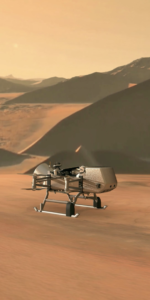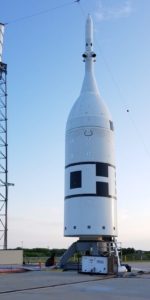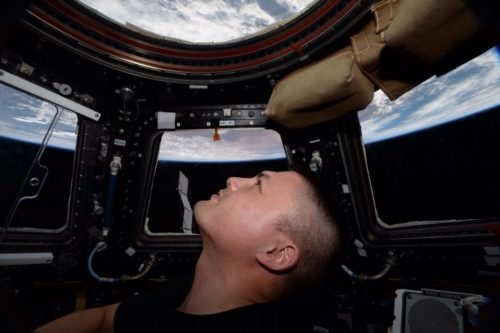
“Chump” Kjell Lindgren gazes out of the multi-windowed cupola on the International Space Station (ISS), during his 4.5-month increment in July-December 2015. Lindgren is today backing up both the first and second piloted flights of the SpaceX Crew Dragon. Photo Credit: NASA
Ten years ago, this week, nine American men and women from the military and civilian spheres, and with backgrounds which ran the gamut from science and technology to engineering and medicine, were announced as NASA’s 20th class of astronaut candidates. Selected from more than 3,500 applicants, a third of their number were female—the largest women-to-men ratio yet picked by the U.S. space agency, a record later surpassed with the 2013 class—and all but one of them have since flown into space, with another on the brink of a second mission.
On 29 June, as a full decade passes since the class now known as the “Chumps” was first introduced to the world, their ranks have accrued over 3.4 years in space and more than 94 hours of spacewalking in 15 sessions of Extravehicular Activity (EVA).
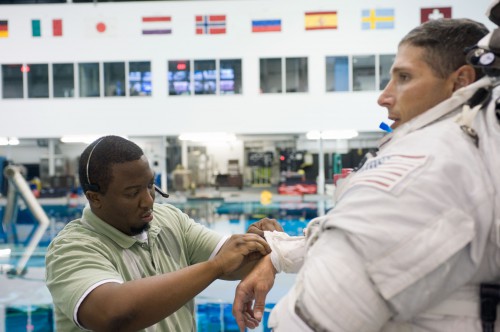
Mike Hopkins prepares for an EVA training session. No spacewalks were initially planned during his Expedition 37/38 increment, but Hopkins wound up performing two EVAs. Photo Credit: NASA
Bill Gerstenmaier, NASA’s Associate Administrator for Space Operations at the agency’s Washington, D.C., headquarters, was not waxing lyrical when he described the new class as “a very talented and diverse group”.
There was a flavor of tradition, with test pilots Reid Wiseman and Scott Tingle selected from the Navy and Jack Fischer from the Air Force, as well as International Space Station (ISS) flight controller Mark Vande Hei, picked from the Army’s NASA detachment at the Johnson Space Center (JSC) in Houston, Texas.
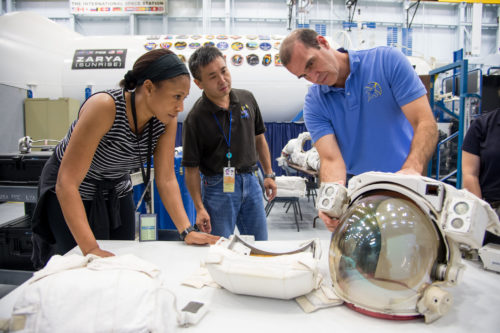
Jeanette Epps works with Expedition 38/39 astronauts Koichi Wakata and Rick Mastracchio in August 2013. Photo Credit: NASA
Air Force officer Mike Hopkins arrived from a role as special assistant to the vice chairman of the Joint Chiefs of Staff at the Pentagon and the class was rounded out with civilian physicians Serena Auñón and Kjell Lindgren, biologist Kate Rubins and aerospace engineer and Central Intelligence Agency (CIA) technical intelligence officer Jeanette Epps.
The selection process had begun in September 2007, with applicants expected to possess the minimum requisite qualifications of a bachelor’s degree in science, engineering or mathematics and three years of relevant professional expertise or extensive experience flying high-performance jets. The deadline for applications closed on 1 July 2008 and, following six months of evaluations and interviews, on 29 June 2009 NASA announced its 20th class of astronaut candidates, 50 years after the legendary Mercury Seven.
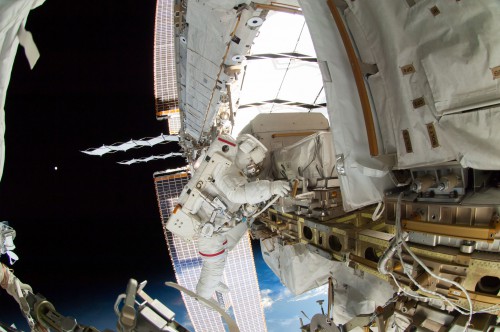
Reid Wiseman spacewalking outside the International Space Station (ISS) in fall 2014. Photo Credit: NASA
The group began training in August 2009 and soon earned the nickname of “the Chumps” from the previous astronaut class, reflecting—in a flipped-over sort of way—their own self-bestowed moniker of “Chimps”. Hopkins was first to draw an official mission assignment, named in February 2011 as a crew member for Expeditions 37/38 and launched on Soyuz TMA-10M in September 2013, shoulder-to-shoulder with Russian cosmonauts Oleg Kotov and Sergei Ryazansky. During his 166 days in space, Hopkins performed two EVAs, one of which fell on Christmas Eve and made him one of only a handful of astronauts to have spacewalked over the festive period.
In May 2014, Wiseman became the second of the Chumps to launch into orbit. Assigned to Expeditions 40 and 41, Wiseman launched aboard Soyuz TMA-13M with Russia’s Maksim Surayev and European Space Agency (ESA) Alexander Gerst, he went on to spend 165 days in space, chalking up a pair of EVAs and returning to Earth in November. Next to fly was Kjell Lindgren, who rode uphill with Russian cosmonaut Oleg Kononenko—currently on-orbit—and Japan’s Kimiya Yui in July 2015. He logged 141 days in space, performing two spacewalks and returning home the following December. Kate Rubins flew for 115 days in July-October 2016 with Russian cosmonaut Anatoli Ivanishin and Japan’s Takuya Onishi, also logging a pair of EVAs and becoming only the 12th woman in history to venture outside her spacecraft in a pressurized space suit.
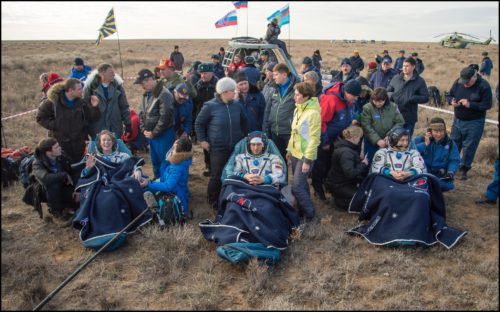
The Expedition 49 crew re-adjust to terrestrial gravity and the sights, sounds and scents of Earth, after landing in October 2016. From left are Kate Rubins, Anatoli Ivanishin and Takuya Onishi. Photo Credit: NASA
Jack Fischer launched alongside veteran Russian cosmonaut Fyodor Yurchikhin in April 2017 and spent 135 days in orbit, with two EVAs, before retiring from NASA in May 2018 to return to the Air Force. Mark Vande Hei is the Chumps’ current EVA record-holder, having totaled four excursions and over 26 hours of spacewalking time during his 168-day mission between September 2017 and February 2018. His ISS increment with Russian cosmonaut Aleksandr Misurkin and NASA’s Joe Acaba crossed over with that of Scott Tingle, whose own 168-day mission between December 2017 and June 2018 with Russia’s Anton Shkaplerov and Japan’s Norishige Kanai wound up lasting just four minutes longer than Vande Hei’s own.
Most recently, Serena Auñón-Chancellor stands as the most flight-experienced member of the Chumps, totaling almost 197 days during her long-duration ISS expedition with Alexander Gerst and Russia’s Sergei Prokopyev in June-December 2018, which was extended slightly following the high-altitude abort of Soyuz MS-10.
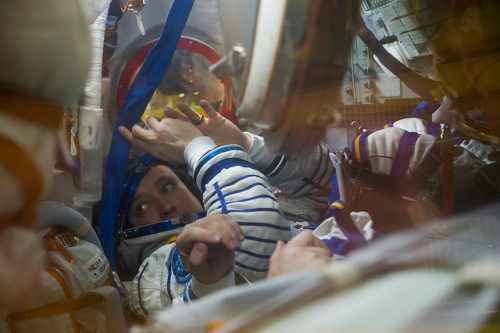
Clad in his Sokol (“Falcon”) launch and entry suit, Jack Fischer participates in an evaluation of Soyuz MS-04 at the Baikonur Cosmodrome, ahead of his April 2017 launch. Photo Credit: NASA
Left currently unflown is Jeanette Epps, who was assigned in January 2017 to fly aboard Soyuz MS-09 and might have become the first African-American long-duration resident of the ISS. However, a year later—for reasons which remain obscure—Epps was removed from the mission and replaced by Auñón-Chancellor, who moved forward from her own slot on Soyuz MS-11.
According to NASA’s Brandi Dean, Epps currently serves in the Mission Support Crew Branch of the astronaut office, with responsibilities covering Exploration, the testing of the Orion crew module “and a number of other activities”. As for Auñón-Chancellor herself, she is wrapping up post-flight rehabilitation from her 28 weeks in space, before rotating into another technical assignment within the office.
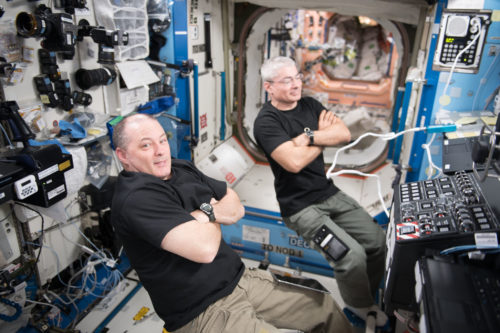
Mark Vande Hei (background) and Scott Tingle in the space station’s Destiny lab during Expedition 54. Photo Credit: NASA
For the other Chumps, Hopkins was in May 2018 serving as assistant to the chief astronaut for Commercial Crew, a position which certainly proved pivotal in securing him a spot on the first dedicated long-duration Crew Dragon mission to the ISS. The target date for that mission has been extensively delayed, not least in the aftermath of the Crew Dragon anomaly at the Cape in April 2019.
Backing him up is Lindgren, who also acted as chief of the assigned crew branch of the astronaut office after his first flight. Lindgren will also fill backup duty for the Crew Dragon Demo-2 manned test flight, ready to step in and replace either Doug Hurley or Bob Behnken, should the need arise.
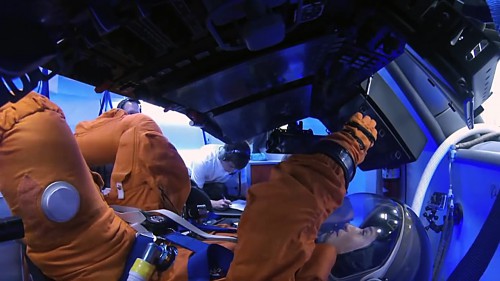
NASA astronaut Serena Aunon-Chancellor conducting flight suit evaluations inside a fully outfitted test version of Boeing’s CST-100 Starliner spacecraft. Photo Credit: NASA/Boeing
Rubins, who was assistant to the chief for EVA after her first flight, is now NASA’s director of operations in Russia, based in the Star City cosmonauts’ training center, on the forested outskirts of Moscow.
Wiseman was deputy chief of the astronaut office from 2017, but in April 2019 was reassigned to an associate directorship in the Flight Operations Directorate (FOD). And since returning from their own ISS missions only last year, Vande Hei now serves as assistant to the chief for EVA and Robotics and Tingle is acting deputy chief of the aircraft operations division.




